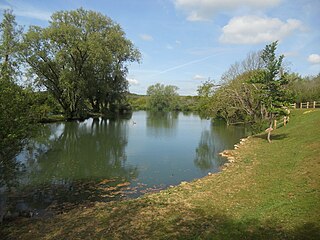Related Research Articles

Dibden is a small village in Hampshire, England, which dates from the Middle Ages. It is dominated by the nearby settlements of Hythe and Dibden Purlieu. It is in the civil parish of Hythe and Dibden. It lies on the eastern edge of the New Forest in a valley, which runs into Southampton Water.

Ellingham is a small village and former civil parish, now in the parish of Ellingham, Harbridge and Ibsley, in the New Forest district, in the county of Hampshire, England. It is near Ringwood, west of the New Forest National Park. Ellingham is most famous for the story of Alice Lisle, who was executed by the infamous Judge Jeffreys in 1685, on the charge of harbouring fugitives after the defeat of the Monmouth Rebellion. In 1961 the parish had a population of 595.

The Great Budbridge Manor is a manor house just south of Merstone, near Arreton, Isle of Wight, England. Fish ponds on the grounds appear medieval.
Branston Manor is a manor house on the Isle of Wight, situated within the Newchurch parish.
Cleaveland Manor is a manor house on the Isle of Wight, situated within the Victoria parish.
Princelet Manor, is a manor house on the Isle of Wight, situated in the Newchurch parish. It a small holding to the south-west of Apse Heath, and was held by the Lisles of Wootton. Of them it was held by the Kingstons of Kingston until the middle of the 14th century. It was held in 1428 by Richard Hearn and John Mayhew. Princelet was purchased at the end of the 16th century by Richard Gard, who in 1617 left an annuity issuing out of it to the poor of Newchurch. In 1780 John White paid a fee-farm rent for it, but in 1837 it was owned by William Thatcher; the owner as of 1912 was Mr. Charles Allen.
Wackland Manor, is a manor house on the Isle of Wight, situated in the Newchurch parish. It was held in the 13th century under the Lisles of Wootton, but in 1311–12 was said to be held of Ralph de Gorges of Knighton Gorges Manor. At the end of the 13th century it was held by John de la Brigge, from whom it passed with Bridge Court (q.v.) to the Kingstons. It followed the descent of Kingston until 1424, when Robert Dingley and Lewis Meux conveyed it to John Taillour, who was returned in 1431 as holding Wackland. Its descent has not been traced from that time until the end of the 18th century. Some time before 1786 it must have been in the possession of Thomas Davis, as he left a charge of 20s. upon it for charities. In the early part of the 19th century Wackland was the residence of a hunting farmer, well known as 'Squire' Thatcher, who kept and hunted a pack of harriers. Mr. E. Carter was lord of Wackland in 1878, and as of 1912 it belonged to the trustees of the late Mr. Thomas F. Perrott.
Briddlesford Manor, is a manor house on the Isle of Wight, situated in the parish of Arreton.
Combley Manor is a manor house on the Isle of Wight, situated in the parish of Arreton. It lies in the low ground to the north of Arreton Down, and mostly consists of woodland and pasture. Its first appearance is in a deed between its then owner Simon Fitz Hubert and the convent of Quarr exchanging it for the somewhat insignificant holding of Blackland. It remained in the possession of Quarr Abbey until its dissolution, but does not appear as a manor till quite late in the 15th century; indeed, in the valuation of Quarr Abbey lands in 1536 it is entered as 'a farm called Combley in Atherton parish.' In February 1537 Combley, called a manor, was granted in fee to Thomas Wriothesley, and it subsequently followed the same descent as Haseley.

Hale Manor is a manor house on the Isle of Wight, situated in the parish of Arreton. It forms the south-eastern portion of the parish adjoining Newchurch, and comprises the high ground to the south of the River Yar above Horringford.
Horringford Manor is a manor house on the Isle of Wight, situated in the parish of Arreton.
Huffingford Manor is a manor house on the Isle of Wight, situated in the parish of Arreton.
Adgestone Manor is a manor house in Brading on the Isle of Wight.
Barnsley Manor is a manor house in the parish of Brading on the Isle of Wight.
Milton Manor is a manor house in the parish of Brading on the Isle of Wight, in England.
Blackpan Manor is a manor house in the parish of Brading on the Isle of Wight.
Park Manor is a manor house in the parish of Brading on the Isle of Wight.
Sandown Manor is a manor house in the parish of Brading on the Isle of Wight.
Durton Manor was a manor house on the Isle of Wight, situated in the parish of Arreton.
Redway Manor is a manor house on the Isle of Wight, situated in the parish of Arreton.
References
This article includes text incorporated from William Page's "A History of the County of Hampshire: Volume 5 (1912)", a publication now in the public domain
- 1 2 3 Page, William (1912). "A History of the County of Hampshire: Volume 5. Victoria County History. Parishes: Arreton". University of London & History of Parliament Trust, accessed through British History Online. pp. 139–151. Retrieved 6 July 2011.